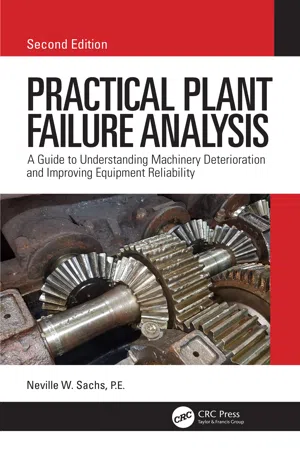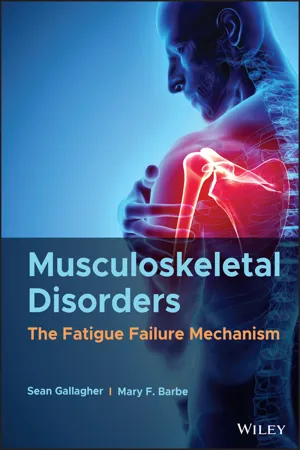Technology & Engineering
Mean Stress
Mean stress refers to the average stress experienced by a material over a given period of time. In engineering, it is an important factor in fatigue analysis and design, as it can contribute to material failure under cyclic loading. Understanding and managing mean stress is crucial for ensuring the structural integrity and longevity of engineering components.
Written by Perlego with AI-assistance
Related key terms
Related key terms
1 of 4
Related key terms
1 of 3
3 Key excerpts on "Mean Stress"
- eBook - ePub
Practical Plant Failure Analysis
A Guide to Understanding Machinery Deterioration and Improving Equipment Reliability, Second Edition
- Neville W Sachs, P.E.(Authors)
- 2019(Publication Date)
- CRC Press(Publisher)
3 Materials and the Sources of Stresses- A. Stress, Strain, and Material Strength
- B. Mechanical Stress
- C. Thermal Stress
Some very basic failure analyses can be accomplished without truly understanding the effects of various stresses and the materials they act on. Unfortunately, as failures become more complicated, this lack of knowledge almost always leads to serious errors and, when one starts looking into more costly or more complex failures, the need to understand exactly what is happening is incredibly valuable.Stress causes parts to bend or break, but all materials don’t react in the same manner. In the real world, a good understanding of stresses and their effects on materials is crucial to accurate failure analysis. (For example, doubling the load on a beam could cause it to deflect twice as much or it could cause an immediate catastrophic failure. But the effect of doubling the load on a rolling element bearing is that its life will be cut by a factor of eight to ten.) In this chapter, we’ll discuss some of those basic definitions and concepts.Stress
When a load is put on a part, the part is stressed . Figure 3.1 shows a block with a cross-section area of 645 mm2 (1 in2 ). With the load of 50,000 N (11,240 pounds), the resultant tensile stress is 77.5 MPa or 11,240 lbs/in2 .In this example, the block is axially loaded and the piece is in tension . In a similar manner, reversing the forces shown here would put the piece in compression. To calculate the magnitude of the stress in the block shown in Figure 3.1 the formulas = p / ais used. In this equation s is the pressure or stress (in MPa or pounds per square inch), p equals the load (in newtons or pounds-force), and a is the stressed area (in square mm or square inches).If the same block were to be subjected to a bending load or a bending moment the stress would be very different as seen in Figure 3.2 . The block in Figure 3.1 is subjected to pure tension and the stress is uniform across it but, as shown in Figure 3.2 - eBook - ePub
Musculoskeletal Disorders
The Fatigue Failure Mechanism
- Sean Gallagher, Mary F. Barbe(Authors)
- 2022(Publication Date)
- Wiley(Publisher)
u ) was 100 MPa, the predicted residual strength would be 97.185 MPa, compared to the original 100 MPa. As with the Palmgren‐Miner rule calculations, we can calculate the percentage decrease in residual strength associated with each of the three fatigue loading conditions. As can be seen, the 250 cycles at 40 MPa was responsible for 61.2% of the decrease in residual strength, with the other two conditions contributing approximately 20% apiece.Effects of Mean Stress on Fatigue Life
Many engineering materials experience fully reversed loaded (alternating compressive and tensile stress reversals) during their service life; however, it appears that this circumstance is less prevalent in musculoskeletal tissues. Instead, the latter tend to experience repeated stress or fluctuating stress (see Figure 9.1 ). In such cases, the Mean Stress experienced by the material will be non‐zero and may have a significant influence on fatigue life. The presence of a moderate to high Mean Stress level during loading can also lead to a phenomenon known as cyclic creep, which may result in additional decreases in fatigue life, and add to the overall deformation experienced by the material (Bazant & Panula, 1979 ). As we prepare to calculate the fatigue life of musculoskeletal tissues encountering variable amplitude loading, we need to introduce techniques that take into account the impact of the Mean Stress on fatigue life.Despite the fact that musculoskeletal tissues rarely experience fully reversed loading, this loading condition plays an important role in the analysis of conditions having variable amplitude loading conditions with nonzero Mean Stresses (common to musculoskeletal tissues). Essentially the fully reversed loading condition serves as the standard loading condition, and variable loading conditions and loading with nonzero Mean Stresses are corrected for and placed in the context of fully reversed loading, as we shall see. - eBook - ePub
Fatigue Design
Life Expectancy of Machine Parts
- Eliahu Zahavi(Author)
- 2019(Publication Date)
- CRC Press(Publisher)
The main consideration in designing a part which is subject to fluctuating loading is to determine the extent of the desired number of cycles to fatigue failure; that is, should it have an infinite fatigue life span or a finite number of cycles? Either can be considered with one fact in mind. For an infinite fatigue life stresses must be kept below the fatigue limit, because stresses above the fatigue limit will cause a failure after a given number of cycles. Different constraints inherent in the design determine the magnitude of stresses and these are the factors that dictate the proper choice. The Stress Method utilizes the fact that there exists a correlation between the working stresses and the number of cycles within the finite life. It is based on the assumption that a part behaves elastically ignoring the occurrence of plastic deformation.3.1TESTS AND TEST RESULTSSince the beginning of machine design, the experimental data has been the practical basis for forecasting failures of machine parts. Most of the methods for forecasting are based on experimental results and the Stress Method discussed in this chapter is no exception. The results of fatigue tests provide a tool for prediction of life expectancy: the correlation of number of fluctuations to the magnitude of applied stresses.One should note that the rate of load fluctuations during tests is a factor that is virtually ignored. Experience shows that within the range of about 1,000 to 10,000 cycles per minute, no perceptible effect of it on the correlation between number of load cycles and stresses has been recorded.There are standard fatigue tests which include rotating-beam and axial-loading tests (see below) to provide the limit values of normal stresses. The results obtained can also be used to derive other limit values as, for instance, the torsional shear fatigue limits. To interpret the test results, however, one must properly use the available statistical tools.3.1.1 Standard fatigue testsDesign of machine parts uses the fatigue information derived from standard tests where stresses fluctuate at constant amplitudes—due to practical constraints—even though most machine parts are subject to fluctuating stresses with random amplitude and mean. See, for instance, the loading history shown in Figure 3.1
Index pages curate the most relevant extracts from our library of academic textbooks. They’ve been created using an in-house natural language model (NLM), each adding context and meaning to key research topics.
Explore more topic indexes
Explore more topic indexes
1 of 6
Explore more topic indexes
1 of 4


